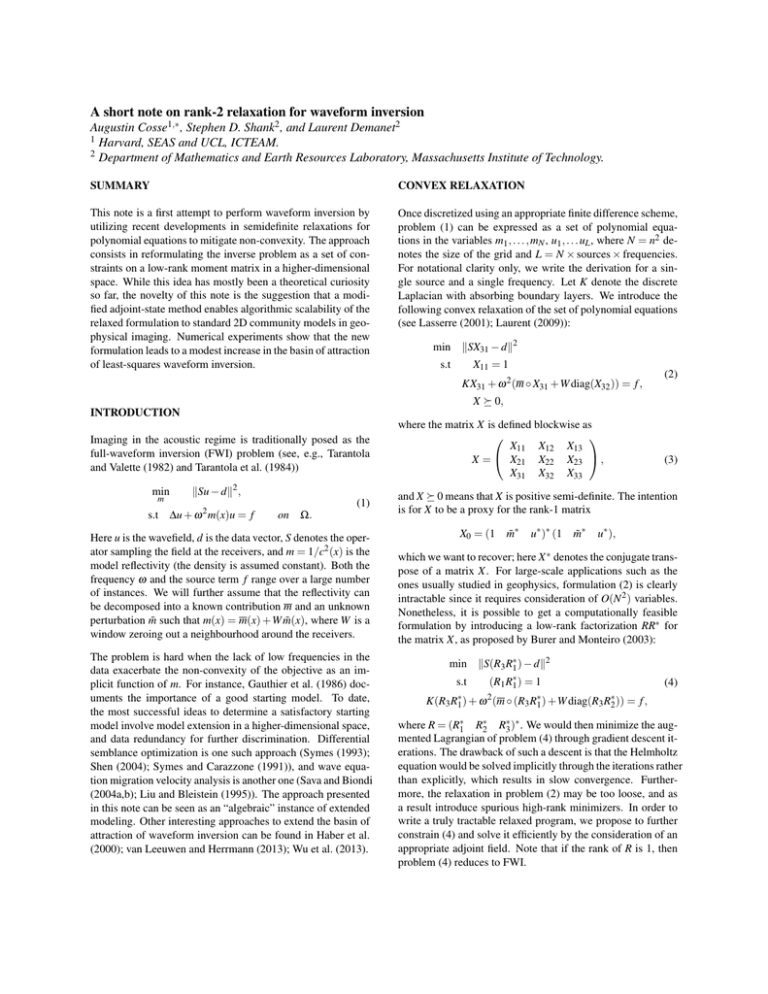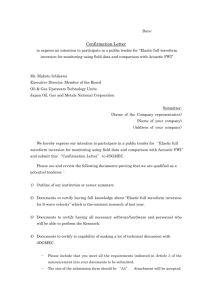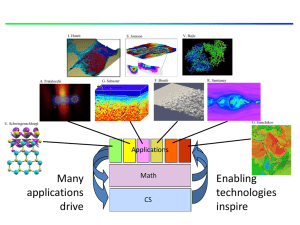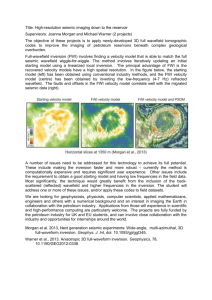A short note on rank-2 relaxation for waveform inversion
advertisement

A short note on rank-2 relaxation for waveform inversion
Augustin Cosse1,∗ , Stephen D. Shank2 , and Laurent Demanet2
1 Harvard, SEAS and UCL, ICTEAM.
2 Department of Mathematics and Earth Resources Laboratory, Massachusetts Institute of Technology.
SUMMARY
CONVEX RELAXATION
This note is a first attempt to perform waveform inversion by
utilizing recent developments in semidefinite relaxations for
polynomial equations to mitigate non-convexity. The approach
consists in reformulating the inverse problem as a set of constraints on a low-rank moment matrix in a higher-dimensional
space. While this idea has mostly been a theoretical curiosity
so far, the novelty of this note is the suggestion that a modified adjoint-state method enables algorithmic scalability of the
relaxed formulation to standard 2D community models in geophysical imaging. Numerical experiments show that the new
formulation leads to a modest increase in the basin of attraction
of least-squares waveform inversion.
Once discretized using an appropriate finite difference scheme,
problem (1) can be expressed as a set of polynomial equations in the variables m1 , . . . , mN , u1 , . . . uL , where N = n2 denotes the size of the grid and L = N × sources × frequencies.
For notational clarity only, we write the derivation for a single source and a single frequency. Let K denote the discrete
Laplacian with absorbing boundary layers. We introduce the
following convex relaxation of the set of polynomial equations
(see Lasserre (2001); Laurent (2009)):
min kSX31 − dk2
X11 = 1
s.t
KX31 + ω 2 (m ◦ X31 +W diag(X32 )) = f ,
(2)
X 0,
INTRODUCTION
Imaging in the acoustic regime is traditionally posed as the
full-waveform inversion (FWI) problem (see, e.g., Tarantola
and Valette (1982) and Tarantola et al. (1984))
min
m
kSu − dk2 ,
2
s.t ∆u + ω m(x)u = f
(1)
on
Ω.
Here u is the wavefield, d is the data vector, S denotes the operator sampling the field at the receivers, and m = 1/c2 (x) is the
model reflectivity (the density is assumed constant). Both the
frequency ω and the source term f range over a large number
of instances. We will further assume that the reflectivity can
be decomposed into a known contribution m and an unknown
perturbation m̃ such that m(x) = m(x) +W m̃(x), where W is a
window zeroing out a neighbourhood around the receivers.
The problem is hard when the lack of low frequencies in the
data exacerbate the non-convexity of the objective as an implicit function of m. For instance, Gauthier et al. (1986) documents the importance of a good starting model. To date,
the most successful ideas to determine a satisfactory starting
model involve model extension in a higher-dimensional space,
and data redundancy for further discrimination. Differential
semblance optimization is one such approach (Symes (1993);
Shen (2004); Symes and Carazzone (1991)), and wave equation migration velocity analysis is another one (Sava and Biondi
(2004a,b); Liu and Bleistein (1995)). The approach presented
in this note can be seen as an “algebraic” instance of extended
modeling. Other interesting approaches to extend the basin of
attraction of waveform inversion can be found in Haber et al.
(2000); van Leeuwen and Herrmann (2013); Wu et al. (2013).
where the matrix X is defined blockwise as
X11 X12 X13
X = X21 X22 X23 ,
X31 X32 X33
(3)
and X 0 means that X is positive semi-definite. The intention
is for X to be a proxy for the rank-1 matrix
X0 = (1
m̃∗
u∗ )∗ (1
m̃∗
u∗ ),
which we want to recover; here X ∗ denotes the conjugate transpose of a matrix X. For large-scale applications such as the
ones usually studied in geophysics, formulation (2) is clearly
intractable since it requires consideration of O(N 2 ) variables.
Nonetheless, it is possible to get a computationally feasible
formulation by introducing a low-rank factorization RR∗ for
the matrix X, as proposed by Burer and Monteiro (2003):
min kS(R3 R∗1 ) − dk2
s.t
(R1 R∗1 ) = 1
K(R3 R∗1 ) + ω 2 (m ◦ (R3 R∗1 ) +W diag(R3 R∗2 )) =
(4)
f,
where R = (R∗1 R∗2 R∗3 )∗ . We would then minimize the augmented Lagrangian of problem (4) through gradient descent iterations. The drawback of such a descent is that the Helmholtz
equation would be solved implicitly through the iterations rather
than explicitly, which results in slow convergence. Furthermore, the relaxation in problem (2) may be too loose, and as
a result introduce spurious high-rank minimizers. In order to
write a truly tractable relaxed program, we propose to further
constrain (4) and solve it efficiently by the consideration of an
appropriate adjoint field. Note that if the rank of R is 1, then
problem (4) reduces to FWI.
A short note on rank-2 relaxation for waveform inversion
P
equation H̃v = f , where H̃ := r`=1 L` L`∗ . The corresponding
reformulation of problem (5) in terms of v reads
THE ADJOINT-STATE METHOD
Early instances of the adjoint-state formalism are found in Lax
et al. (1957), Lions and Magenes (1972), and Chavent and
Lemonnier (1974). Extensions and applications to geophysics
include Tarantola (1984, 2005). A review is in Plessix (2006).
min J(α, v) = k
r
X
α` SL`∗ v − dk2
`=1
s.t
H̃v = f ,
r
X
(6)
α`2 = 1.
The adjoint-state method is helpful in that it provides the expression of the gradient for FWI without having to compute
or store the Fréchet derivatives of the field δm u. Let H :=
∆ + ω 2 m(x). The equations of the adjoint-state method for
problem (1) follow from minimizing the Lagrangian
n
o
L (u, m̃, q) = Re kSu − dk2 − hq, H(m̃)u − f i ,
√
Introducing the adjoint field q = qR + iqI , i = −1, the Lagrangian and its partials are given by
L (α, v, m̃; q) = J(α, v) − Re hq, H̃(α, m̃)v − f i ,
by moving along the gradient direction in m̃, while setting the
partials with respect to q and u to 0. These zero-derivative
conditions respectively imply the Helmholtz equation Hu = f
for the (state) field u, and the adjoint equation H ∗ q = w for the
(adjoint state) field q, where w = S∗ (Su − d) is the residual. An
imaging condition then links u and q to form the model update.
See the review by Symes (2009) for more details on the history
and the mathematics of the adjoint-state method.
∂J
∂ H̃v
∂L
=
− Rehq,
i,
∂α
∂α
∂α
∂L
∂J
∂
=
− Rehq,
H̃vi,
∂ m̃
∂ m̃
∂ m̃
∂L
∂J
=
− Re{(H̃ ∗ q)},
∂ Re{v} ∂ Re{v}
∂L
∂J
=
− Im{(H̃ ∗ q)}.
∂ Im{v} ∂ Im{v}
Rank-r formulation
This section introduces a version of the adjoint-state method to
deal with problem (4), when the matrix R (hence X = RR∗ ) has
fixed rank r > 1. From now on, we assume that R ∈ Ch×r , h =
1+N +L. Denote its blocks by R1 = [α1 , . . . , αr ] ∈ R1×r , R2 =
[m1 , . . . , mr ] ∈ RN×r , R3 = [u1 , . . . , ur ] ∈ CL×r , which then leads
to a representation of X as a sum of rank-1 matrices,
r
α`2
α` m̃∗` α` u∗`
X
∗
α` m̃` m̃` m̃∗ m̃` u∗ .
X ≈ RR =
`
`
α` u` u` m̃∗` u` u∗`
`=1
We then apply the constraints of formulation (2) to this last
expression. This leads to the following problem, revealing a
rank-r version of the Helmholtz equation,
min
r
X
`=1
2
(5)
2
α` Ku` + ω α` m ◦ u` + ω W m̃` ◦ u` = f .
Least-squares and gradient computations
The adjoint-state framework cannot directly be applied to formulation (5) because the rank-r Helmholtz equation is underdetermined, and therefore does not possess a unique solution.
Let L` (α` , m̃` ) := α` K +ω 2 (α` m+W m̃` ), and L = [L1 , . . . , Lr ],
so that the rank-r Helmholtz equation reads Lu = f . Explicitly,
r
X
(L2)
(L3)
(L4)
Following the traditional approach, we set (L3) and (L4) to
zero. Let α̃ and S̃ denote the operators α̃ = [α1 IN , . . . αr IN ]
and S̃ = Ir ⊗ S, respectively. We can derive the solution of the
adjoint equation as
q =(H̃ ∗ )−1 (α̃ S̃L∗ )∗ (α̃ S̃L∗ v − d).
The partials of H̃ with respect to m̃` and α` , 1 ≤ ` ≤ r can be
expressed as
hq, ∂α` H̃i =2α` hq, K(K ∗ v)i + hq, 2ω 4W m̃` ◦ m ◦ vi
+ α` hq, 2ω 4 m2 ◦ vi
+ hq, K(ω 2W m̃` ◦ v)i + 2α` hq, K(ω 2 m ◦ v)i
hq, ∂m̃` H̃i =qω 4 2α` ◦ m ◦W v + 2qω 4 ◦W 2 m̃` ◦ v+
`=1
Lu =
(L1)
+ hq, ω 2W m̃` ◦ K ∗ vi + 2α` hq, ω 2 m ◦ K ∗ vi.
r
r
X
1 X
k
α` Su` − dk2 s.t.
α`2 = 1,
2
`=1
`=1
α` Ku` + ω 2 (α` m ◦ u` +W m̃` ◦ u` ).
`=1
A natural simplification is to consider the underdetermined
least-squares (LS) solution to Lu = f . This is accomplished
by requiring u` = L`∗ v, and finding v by solving the normal
α` (K ∗ (q))ω 2 ◦W v + qω 2 ◦W α` ∆∗ v.
The partialsP
of the objective ∂α` J, ∂m̃` J are given by ∂α` J =
2Re{hSL`∗ v, ` α` SL`∗ v − di}; and ∂m̃` J = 0.
ALGORITHM
The rank-2 adjoint-state method (henceforth R2AS) is summarized in Algorithm 1. We restrict to rank r = 2 since no substantial improvement was observed at higher ranks. We use
coordinate descent, first minimizing over all m̃` , followed by
minimizing over all α` . These minimizations are performed
using LBFGS (see Liu and Nocedal (1989)) from the knowledge of the gradients (L1) and (L2). We then normalize the α`
to ensure that they reside on the unit sphere. Finally, the approximation for m is extracted by computing the leading eigenvector of RR∗ , appropriately scaled.
A short note on rank-2 relaxation for waveform inversion
Algorithm 1 Rank-2 Adjoint State (R2AS)
Input: Initial iterates α (0) ∈ R2 , m̃(0) ∈ RN×2
Output: Approximate reflectivity m̃?
2
X
1: while k
α` SL`∗ u` − dk/kdk > ε do
20
40
4:
5:
6:
7:
8:
Numerical Experiments
All numerical experiments are conducted by adding 0.1% additive Gaussian white noise to the data. The rank-2 method is
initialized by taking as first column an initial guess m̃(0) for
which the adjoint-state method may fail, and as second column an uninformative perturbation (arbitrarily chosen as an
oscillatory bump g, times ascalar
β ) of thesame vector, i.e.,
1
1
0 0
R(0) = √1
+
.
2
0 βg
m̃(0) m̃(0)
Example 1: Camembert
We first benchmark our method on a version of the Camembert
example (see Gauthier et al. (1986) and Fig.1). The domain is
80 × 80 (grid points) with a background reflectivity of 1, contrast κ = max(1/c2 ) − min(1/c2 ) ranging from .5 to .6, and a
narrow frequency band between 1.5/(2π) and 1/π. Receivers
and sources are placed all around the domain.
80
Contrast
3:
Compute the LS field : v = H̃ −1 f
(Forward Step)
LBFGS step in m̃
LBFGS step in α
(Backward step)
Projection of α onto the unit sphere:
α ← α/kαk.
Compute u as u = L∗ v.
end while
Obtain m̃? as
p
RR∗ = λ1 ν1 ν1∗ + λ2 ν2 ν2∗
m̃? = ( λ1 ν1 )2
1.2
60
`=1
2:
1.4
1
20 40 60 80
0.6
0.575
0.55
0.525
0.5
0.1 0.2 0.3 0.4 0.5 0.6 0.7 0.8 0.9
1
Magnitude of perturbation
Figure 1: Top: Setup and recovery of R2AS for the Camembert
example (reflectivity map with contrast κ = .51). Bottom: Performance of R2AS on the Camembert map for varying magnitudes of perturbation to the second column β and contrasts κ.
A red dot indicates convergence for the corresponding pair of
parameters, while a blue dot indicates failure.
Results
The R2AS approach leads to an increase of 5% to 10% in the
basin of attraction of FWI for each model considered here.
This improvement is measured with respect to the contrast for
the Camembert and Shepp-Logan models, and with respect to
the amount of smoothing of the Marmousi model.
The bottom portion of Fig. 1 plots the magnitude of the perturbation to the second column β against the contrast of the
Camembert model. Higher contrasts are more difficult to handle, and FWI gets trapped in spurious local minima when κ ≥
.51. A higher β intuitively represents a stronger push of the
matrix X away from the rank-1 manifold. Success at rank 2 and
higher may be attributed to the ability of escaping the rank-1
local minima by operating in a higher-dimensional space.
Example 2: Shepp-Logan phantom
Full-waveform inversion is initialized with background m =
(1 − W )m0 , m̃(0) = 1. The domain is of size 120 × 120 (grid
points) and the reflectivity constrast varies between .8 and 1.
The frequencies are taken equispaced between 1.5/(2π) and
1/π. The receivers and sources are placed all around the domain as shown in Fig. 4.
Example 3: Marmousi 1
We finally apply our method to the Marmousi model (see Versteeg (1994)) at frequencies ranging from about 3.3 to about
6.4 Hz. This is in accordance with usual simulations (see for
example Sirgue and Pratt (2004)). Receivers and sources are
positioned at the surface (see Fig. 2, top). The initial guess
is obtained by smoothing the original image with a Gaussian
kernel of varying widths. Traditional full-waveform inversion
starts failing for smoothing above 35 grid points. Our method
recovers the right map for a smoothing of up to 40 grid points.
For the best results, α1 and α2 should be chosen to be very
different.
CONCLUSION
We have presented a variant of the adjoint-state method to efficiently solve the rank-2 moment relaxation of FWI. The improvement in local convexity around the global minimizer is
intuitively explained by the ability to find better paths around
local minima when performing the descent in a higher-dimensional
space. The proposed approach yields a 5-10% enlargement of
the basin of attraction for standard 2D community models.
ACKNOWLEDGMENTS
AC thanks the Belgian National Science Foundation (FNRS)
and MISTI Belgium for support. LD and SS thank Total SA.
LD is also supported by AFOSR, ONR, and NSF. AC would
like to thank Yunyue Elita Li and Leonardo Zepeda-Núñez for
interesting discussions.
A short note on rank-2 relaxation for waveform inversion
0.26
2
0.24
1.5
0.22
1
0
5000
1000
4000
2000
3000
3000
2000
0
2000
4000
6000
0.2
0.5
0.18
0.16
10 0
0
10 0
10 2
10 0
10 1
10 2
10 1
10 2
10 0
8000
10
0
-1
10
-1
5000
1000
4000
2000
3000
10 -2
10 0
10 2
10 -2
10 0
1000
Figure 3: Top: Relative error for the Marmousi map (L) and
the Shepp-Logan map (R). The error curve corresponding to
R2AS is shown in red, the curve corresponding to imaging
through full-waveform inversion is shown in blue. Bottom:
Misfit for the Marmousi map (L) and Shepp-Logan map (R).
5000 Again the curves corresponding to R2AS are shown in red, the
ones corresponding to full-waveform inversion in blue.
2000
3000
3000
2000
0
2000
4000
6000
8000
0
3000
4000
2000
0
2000
4000
6000
8000
1.8
0
5000
1000
4000
2000
3000
3000
2000
0
2000
4000
6000
8000
0
1.4
1.2
1
5000
2.5
1000
4000
2000
3000
3000
1.6
2000
0
2000
4000
6000
8000
2
1.5
1
0.5
Figure 2: Marmousi. From top to bottom: Original configuration (sources and receivers are placed at the surface, and depicted by red crosses and white triangles, respectively); image
recovered from rank-2 relaxation; image recovered through
traditional least-squares inversion; initial u component of the
first column of R (as well as initial guess for FWI); and initial
u component of the second column of R.
0
Figure 4: Shepp-Logan (reflectivity map). Recovered image for R2AS (top) and FWI (bottom) when starting from
m = (1 − W (x))m0 background and m̃0 = 1 initial perturbation. Receivers and sources are shown as white triangles and
red crosses, respectively.
A short note on rank-2 relaxation for waveform inversion
REFERENCES
Burer, S., and R. D. Monteiro, 2003, A nonlinear programming
algorithm for solving semidefinite programs via low-rank
factorization: Mathematical Programming, 95, 329–357.
Chavent, G., and P. Lemonnier, 1974, Identification de la nonlinéarité d’une équation parabolique quasilinéaire: Applied
mathematics and Optimization, 1, 121–162.
Gauthier, O., J. Virieux, and A. Tarantola, 1986, Twodimensional nonlinear inversion of seismic waveforms:
Numerical results: Geophysics, 51, 1387–1403.
Haber, E., U. M. Ascher, and D. Oldenburg, 2000, On optimization techniques for solving nonlinear inverse problems: Inverse problems, 16, 1263.
Lasserre, J. B., 2001, Global optimization with polynomials
and the problem of moments: SIAM Journal on Optimization, 11, 796–817.
Laurent, M., 2009, Sums of squares, moment matrices and optimization over polynomials, in Emerging applications of
algebraic geometry: Springer, 157–270.
Lax, P. D., et al., 1957, Asymptotic solutions of oscillatory initial value problems: Duke Mathematical Journal, 24, 627–
646.
Lions, J. L., and E. Magenes, 1972, Non-homogeneous boundary value problems and applications: Springer Berlin.
Liu, D. C., and J. Nocedal, 1989, On the limited memory
BFGS method for large scale optimization: Mathematical
programming, 45, 503–528.
Liu, Z., and N. Bleistein, 1995, Migration velocity analysis:
Theory and an iterative algorithm: Geophysics, 60, 142–
153.
Plessix, R.-E., 2006, A review of the adjoint-state method for
computing the gradient of a functional with geophysical
applications: Geophysical Journal International, 167, 495–
503.
Sava, P., and B. Biondi, 2004a, Wave-equation migration velocity analysis. I. Theory: Geophysical Prospecting, 52,
593–606.
——–, 2004b, Wave-equation migration velocity analysis. II.
Subsalt imaging examples: Geophysical Prospecting, 52,
607–623.
Shen, P., 2004, Wave equation migration velocity analysis by
differential semblance optimization: PhD thesis, Rice University.
Sirgue, L., and R. G. Pratt, 2004, Efficient waveform inversion
and imaging: A strategy for selecting temporal frequencies:
Geophysics, 69, 231–248.
Symes, W., 2009, The seismic reflection inverse problem: Inverse problems, 25, 123008.
Symes, W., and J. J. Carazzone, 1991, Velocity inversion by
differential semblance optimization: Geophysics, 56, 654–
663.
Symes, W. W., 1993, A differential semblance criterion for
inversion of multioffset seismic reflection data: Journal
of Geophysical Research: Solid Earth (1978–2012), 98,
2061–2073.
Tarantola, A., 1984, Inversion of seismic reflection data in the
acoustic approximation: Geophysics, 49, 1259–1266.
——–, 2005, Inverse problem theory and methods for model
parameter estimation: SIAM.
Tarantola, A., et al., 1984, The seismic reflection inverse problem: Inverse problems of acoustic and elastic waves, 104–
181.
Tarantola, A., and B. Valette, 1982, Generalized nonlinear inverse problems solved using the least squares criterion: Reviews of Geophysics, 20, 219–232.
van Leeuwen, T., and F. J. Herrmann, 2013, Mitigating local
minima in full-waveform inversion by expanding the search
space: Geophysical Journal International, 195, 661–667.
Versteeg, R., 1994, The Marmousi experience: Velocity model
determination on a synthetic complex data set: The Leading
Edge, 13, 927–936.
Wu, R.-S., J. Luo, B. Wu, et al., 2013, Ultra-low-frequency
information in seismic data and envelope inversion: Presented at the 2013 SEG Annual Meeting, Society of Exploration Geophysicists.





